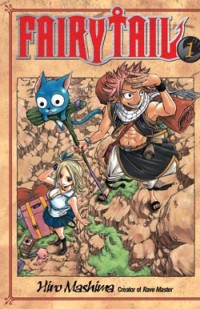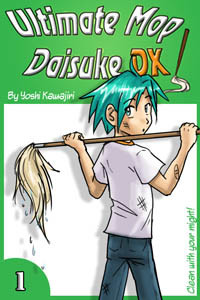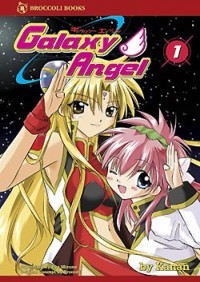RIGHT TURN ONLY!!
April Fooly Cooly
by Carlo Santos,

True bookstore story. A couple of Japanese tourists wander into the manga aisle and are instantly surprised, as it looks a lot like the stuff they have back home, only different. How curious! So then they do what all good tourists do.
One of them stands in front of the shelves. The other takes out her camera.
"Manga deeee~su." Peace sign. Click.
They came from Japan, to America, to look at American tourist attractions, and one of the attractions turned out to be ... Japanese comics. I think my head stopped spinning about 20 minutes later.
AIR GEAR

Vol. 7
(by Oh!great, Del Rey, $10.95)
FROM THE BACK COVER:
"Ikki's the captain of a pretty good extreme skating team ... pretty good, that is, for a bunch of newbies! The players have more heart than talent, but so far, that's landed them close to the top. Now they're facing a matchup that's going to take more than guts to win: a battle to the death with Behemoth, the most reckless, cruel, and murderous team in the league!"
EVIDENCE FOR:
Alas, my worst fears have been realized—Air Gear has turned into a shounen fighting tournament series! But in some ways, this is a good thing, because there's never been a tournament quite like this: eye-popping action scenes that make Naruto look like stick figures, fighting techniques that stretch the limits of physics (without using the "spirit power" excuse), and badass characters who happily cuss and throw up their middle fingers. It's like seeing all the best parts of a great action series turned up to maximum intensity, and then some. Most importantly, what could be more intense than Oh!great's artistic technique? This guy tosses in perfectly rendered tanks and fighter jets, twists the rules of perspective at will, and doesn't miss a single speedline, sound effect, or speck of debris. Even the underlying story is starting to get interesting: what's the deal with Agito? Why is he dragging Ikki's squad into a fight they're almost guaranteed to lose? Keep that plot point in mind, because it's almost too easy to get lost in these amazing fights—especially with so much more to come.
EVIDENCE AGAINST:
So much more to come? Of this over-the-top snorefest? It takes a whole 4 chapters (that's half the book!) just to get to the start of the fight between Ikki's team and the Behemoth gang, and then the rest of it simply shuttles back and forth between two duels. If things keep going at this pace, we might as well start asking if they're still in Soul Society or Namek. It may be turned up to maximum intensity with artwork and attitude, but all that style is useless without any substance—and after seeing the generic tournament setup here, there's definitely no substance to be found. There are also times when the "X-treeeeme!!!" factor goes too far: the jive-talking DJ at the tournament is just cringe-inducing, and some of the exaggerated physical abilities are too wacky to believe, spirit power or not. What happened to the racing? The skating on air? That's the stuff that made Air Gear unique, not this schlocky one-on-one combat. If I wanted that, I could get the same thing from Viz for $7.95, if you know what I mean.
FINAL VERDICT:
It's really, really nice to look at, and it gets the excitement level just right. But let's face it—the cookie-cutter storyline makes it no more than a C.
FAIRY TAIL

Vol. 1
(by Hiro Mashima, Del Rey, $10.95)
FROM THE BACK COVER:
"Cute girl wizard Lucy wants to join the Fairy Tail, a club for the most powerful wizards. But instead, her ambitions land her in the clutches of a gang of unsavory pirates led by a devious magician. Her only hope is Natsu, a strange boy she happens to meet on her travels. Natsu's not your typical hero—he gets motion sickness, eats like a pig, and his best friend is a talking cat. With friends like this, is Lucy better off with her enemies?"
EVIDENCE FOR:
Let's not think about the story for a moment. Don't even think about the characters. Just look at the background art—isn't it beautiful? In a world where wannabe artists usually save backgrounds for last, it's refreshing to see Hiro Mashima put such effort into building a new fantasy world. The intense detail and mastery of perspective also carry right over into the action scenes, where special effects and super-tricky angles make every battle an epic one. In fact, that epic feeling resounds throughout the whole volume: Natsu and Lucy's first escapade is an impressive 80 pages, and once Lucy gets introduced to the Fairy Tail guild, she's promptly whisked off on another adventure that takes her to a snowbound mountaintop (yet another good excuse for some stunning background work). Characters and humor also add to the appeal—Natsu is cocky but likable, Lucy adds the necessary voice of reason, and her magical summons are often good for a laugh (I'll never see the constellation Taurus the same way again). Fairy Tail may lie within a very familiar genre, but this is an example of how to do that genre well.
EVIDENCE AGAINST:
It may be an example of a genre done well, but that just means it's even easier to spot all the cheap tricks and clichés that pop into the story. For example: Natsu has daddy issues! Gee, who didn't see that one coming? Even the basic premise of the story feels like a direct rip from Mashima's own Rave Master, with a plucky boy hero who sets out on wild adventures accompanied by a cute but talented girl and a funny animal mascot. Oh, and, speaking of animal mascots, what is Plue doing in this series? That one's got gimmick written all over it. Even more gimmicky are the "wacky reaction faces" that Lucy puts on everytime something ridiculous happens; that style of visual comedy just doesn't fit in with the rest of the series' artwork, and it'd probably be better if she were just tossing out snippy lines of dialogue instead.
FINAL VERDICT:
The basic story idea and plot devices are pretty ordinary, but the stunning background art and sense of adventure are strong enough to make it a B.
FLCL (novel)

Vol. 1
(by Yoji Enokido, concept by Gainax, Tokyopop, $9.99)
FROM THE BACK COVER:
"Naota's life is not simple. He lives with his eccentric father and grandfather in a city distinguished by a gigantic hand-iron shaped factory perched on a hill. His brother's ex-girlfriend makes passes at him. And to top it all off, an impish, playful alien has run him over with her Vespa and smacked him in the head with a bass guitar! Little does he know that this is only the beginning of his involvement in an interplanetary ideological war."
EVIDENCE FOR:
Most people who saw the FLCL anime left the series with a general feeling of "What the hell just happened?" Luckily, the novel has some of the answers! Unlike the near-incomprehensible manga, this adaptation of Gainax's craziest project is a fairly straight reading of the OVA, with Volume 1 covering the first two episodes and adding just the right twists of extra back-story and character moments. Readers can finally get inside Naota's head (watch out for dimension-hopping robots!) and understand his jaded views on life, as well as stepping into the emotional insecurities of high school girl Mamimi. This story also plays up the conspiracy between Vespa-riding Haruko and the mysterious Medical Mechanica organization, adding some intergalactic intrigue to the plot. The smooth, matter-of-fact writing style is best suited to the rhythms of school life and growing up, yet when robots and aliens come crashing in, it still feels perfectly in tune with the story. What you get, ultimately, is a very unique dose of slice-of-life sci-fi.
EVIDENCE AGAINST:
There are some things that work better in prose than on screen ... and then there are some things that work better on screen than in prose. Sadly, this novel waters down a lot of the craziness found in the original anime—take the infamous "manga panel sequence," for instance, which ends up as just another scene in the book with some mildly quirky dialogue. The robot battles, too, are the weakest part of the entire novel: a shopping list of special moves and attacks, even with accompanying illustrations, just can't match the excitement of seeing it in real time. But the real drawback of this novel, at least for paying readers, might be the cost of the content: $10 for 120 pages? Are they joking? That's as bad as the actual FLCL DVDs where they gave you 2 episodes for $30 and there weren't any discounts for ages.
FINAL VERDICT:
The casual writing style and well-developed characters make this a very enjoyable read—but at 120 pages, there's just not enough to enjoy. B- for now until they come out with an "ultimate edition" that packs all 3 volumes together.
HONEY AND CLOVER

Vol. 1
(by Chica Umino, Viz Media, $8.99)
FROM THE BACK COVER:
"Takemoto, an art student in Tokyo, thinks his greatest worries in life are finding ways to eat more meat and getting to class on time. But with friends like this, life is never going to be that tame. Love triangles—who says you don't learn math in art school?"
EVIDENCE FOR:
It begins with Takemoto, but it quickly becomes so much more—in the space of just one volume, Honey and Clover introduces us to an unforgettable world of complex characters and relationships. Equal parts drama, romance and comedy, this series hits every note just right: the blossoming of love between boy-next-door Takemoto and pint-sized genius Hagumi, the hilarious antics of 7th-year senior Morita, campus beauty Ayumi pining longingly for aloof Mayama, and of course, the heroic stature of Lohmeyer the meat guy. (Does he ever come back?!) The chapters are short, but all it takes is a few pages for Umino to sketch a complete slice-of-life portrait, whether it's Takemoto's reflection on why Christmas depresses him, or something more lighthearted like Hagu losing a picnic watermelon in the river. The artwork itself also has a "sketched" quality to it, with gentle lines and subtle facial expressions bringing out the characters' complex emotions. It may be just the start of the series, but it's already like meeting a group of friends that you never want to let go.
EVIDENCE AGAINST:
They may be a good group of friends, but there's still a little first-time awkwardness. The number of intertwining characters and storylines leads to an episodic jumble in this debut volume—there never seems to be enough time to dig into one specific plotline, and the comedic asides (entertaining as they might be) keep getting in the way. The artwork also suffers from some roughness around the edges; there are moments of remarkable beauty, but others where it's just ultra-bold pen lines scratched into the nearest available space. And it's not just the style that gets messy, but the way the panels are laid out as well—characters and scenes colliding with each other, dialogue crammed in every which way, and little details that are too easily missed. Maybe those short chapters weren't such a good idea after all.
FINAL VERDICT:
It may not be perfect in its execution, but the unique and lovable characters—as well as the perfect blend of serious and silly elements—are still worth an A-.
I·O·N

(by Arina Tanemura, Viz Media, $8.99)
FROM THE BACK COVER:
"Ion Tsuburagi chants the letters of her first name as a charm to bring good luck when she needs it. Then she meets Mikado Hourai, the president of the Psychic Powers Research Society at school and touches a mysterious substance he been developing. Now chanting I-O-N gives her telekinetic powers!"
EVIDENCE FOR:
At just one volume long, I·O·N is an adorable dose of Arinacchi-style romance without all the baggage that comes with her longer series (I'm looking at you, Gentlemen's Alliance of Not-Making-Sense). The main characters have the right kind of appeal—Ion is cheerful, but not overly so, and Mikado's love of the paranormal gives him a geeky-cute sort of quality. Heck, even the annoying student council president is endearing in his own hapless way. We can also be thankful that, for once, "psychic manga" does not mean overpowered superhero battles; Ion's abilities play a secondary role to the main story, which is all about the evolving feelings between her and Mikado. And things really do start to evolve after the first half of the book: revelation, heartbreak and redemption all await in the final act, which is surprisingly dramatic even for a one-shot. Flowery backgrounds and expressive artwork add the final touch to this innocent portrait of love.
EVIDENCE AGAINST:
Even early on in her career, you can see how white space and clean layouts are just not Arina Tanemura's thing. Screentones and background patterns show up where they really aren't necessary, and panels are crammed in together to take up as much space as possible. Eyestrain awaits in scenes like the one where Ion shows up in a yukata, and you can't even appreciate the yukata, because there's too much going on in the background. On another artistic note, the character designs aren't very memorable here—Ion and friends look like typical high school boys and girls for their genre. The story, too, is fairly typical, despite all the twists and drama: boy meets girl, boy isn't sure if he likes girl, Something Important happens, boy realizes he likes girl after all. And it would have been nice if the author's notes didn't keep giving away the details of plot. Spoiler alerts, please!
FINAL VERDICT:
Not the most unique story, and hard to read at times, but likable characters and a dramatic finish earn it a B-. Arinacchitards can pretend it got an A- if it makes them feel better.

ULTIMATE MOP DAISUKE DX

Vols. 1-27
(by Yoshi Kawajiri, Shueisha, ¥420 ea.)
FROM THE BACK COVER:
"Daisuke Arai is a 14-year-old boy with a unique ability—he can clean up a room faster and better than any professional custodian! When Daisuke's skills are discovered by a veteran janitor, he promptly embarks on a quest to become the greatest cleaner the world has ever known. However, it will not be easy, as many challenges and rivals await him. Armed with a mop, a bucket, and a keen eye for the smallest speck of dirt, Daisuke is ready to sweep the world off its feet!"
EVIDENCE FOR:
I used to think that the greatest, most epic manga ever was Some Important-Sounding Title by Osamu Tezuka. But that was before I discovered Ultimate Mop Daisuke DX, which not only kicks reason to the curb and pierces the heavens, but basically runs over reason with an 18-wheeler and tears the heavens open with a mop of DESTINY! The first 27 volumes of Daisuke's exploits are a shining example of all the things we love about manga: unforgettable characters, excitement at every turn, limitless creativity, and scenes that will be burned into your mind's eye forever. You think you know action? Just wait until the battle between Daisuke and Hiroshi in Volume 9, which pushes the molecular chemistry of water to its limits. You think you know romance? Check out Volume 14 where Daisuke experiences his first love—and his first heartbreak—in a story that would bring even Ai Yazawa to her knees. You think you know sci-fi? Oh, you just haven't seen the time-travel arc yet, where Daisuke takes on the 250-foot-tall mecha janitor Peroxzaider. Pulling it all together is an artistic style so intense, and so precise, that it seems every other page is a mind-blowing feast for the eyes. From ultracool characters to geometry-defying layouts to hyper-innovative fight scenes, that art of Daisuke is literally changing the way manga is made. Wherever this adventure leads next, UMD is truly a triumph of the human spirit.
EVIDENCE AGAINST:
Please, please don't read after the time-skip in Volume 28. The new arc sucks pants.
FINAL VERDICT:
Let it be known now: this is, and forever shall be, the only manga in the history of this column to earn a full A+.

RTO's readers are stepping up to the challenge! This week, Sonja tells us about the good points of the Galaxy Angel manga. P.S. By the way, where are all the yaoi reviews? Don't tell me the entire fandom is boycotting my column!
GALAXY ANGEL

(by Kanan, Broccoli, $9.99 ea.)
I was actually pretty new to the whole manga scene when I picked up this title (about 4 years prior to now), hot off the heels of collecting Tokyo Mew Mew. I decided to pick it up for its gorgeous art, expecting something incredibly good. But Galaxy Angel is pretty much normal; even so, it is my favorite manga to date.
The story follows the Angel Brigade, a troupe of 5 lovely young female operatives of "Lost Technology", which in this case are huge ships capable of fighting the exiled Lord Eonia, who is after Prince Shiva to get inside of the "White Moon" where the Moon Goddess Shatoyan hides. The Angels meet a young, peace loving commander named Takuto, and join him to protect the valuable prince. The main goal of the story is not saving Shiva, but actually Milfie [Milfeulle Sakuraba] and her romantic endeavors with Takuto, and is filled with many comedic scenes that could make some laugh out loud or more critical people think, "How clichéd!" Inside the story, you can find how serious the tone is underneath the comedic approach, compared to the other media in the series.
The art is reminiscent of an angel, from the delicate strokes (like when the Nanomachine changes shape) and dainty hands that are drawn. Kanan emphasizes bodies and facial structures, rather than those sugary shoujo eyes that can lead you into a pit of blindness when choosing titles, and hides deeper meaning inside. The story is rather bitter and cruel, and shows faults in people and how you overcome the faults to express yourself. (Ranpha not being able to loosen up her pride to tell Takuto she liked him until [Galaxy Angel] Beta, for example.)
If you like a laid-back comedy with as much action as romance, this title is good for you. If you're looking for that cute romance shojo, or perhaps that action-packed story, you're probably better off not reading it. The story has a few loop-holes and is complicated even with the help of the Galaxy Angel file inserts.
This is what makes Galaxy Angel my favorite, beyond compare, to any other series in my eyes.
Is there a hidden gem of manga you'd like to reveal to the world? Is there a piece of garbage that deserves to be bashed in public? Or is there a title that didn't get a fair grade here, and you want to set the record straight?
Now's YOUR chance to be the reviewer! Write a review of 400 words and include:
- Your name
- Title of manga (and volume no., if applicable)
- Author/Artist
- Publisher
- Briefly describe the story, then explain why this manga is great, terrible, or in between. Be objective, but also be entertaining.
Then send it in to rtoreaders (at) gmail (dot) com. One review will be selected out of all the submissions and will be published in the next column. All types of manga and manga-inspired comickry are accepted, from past and present, from Japan and beyond—what matters is that it's the Reader's Choice! NOTE: Entries may be edited for grammar and formatting.
discuss this in the forum (77 posts) |